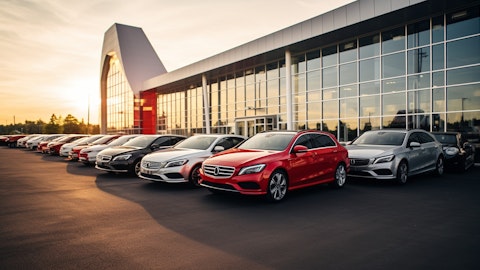So that’s an aspect of 2024 as we start the year. And again, I think the general overall market macro conditions for our Outside North America Off-Highway business can continue to be relatively strong. So we’ll do our best, again, to supply. I think some of that, though, gets back to ultimately the broader industry’s capability in terms of total component supply meeting demand from a time perspective. So, again, we’ll do our best, but we still see that as a relatively strong market.
Tami Zakaria: Great. Thank you.
Operator: Thank you. Our next question comes from the line of Angel Castillo with Morgan Stanley. Please proceed with your question.
Angel Castillo: Hi. Thanks for taking my question. Just wanted to get a little bit more color. You talked about the 200 basis points of price. If we could just kind of walk that through and maybe more current sort of price-cost dynamic and what you kind of anticipate from a margin standpoint? Then maybe continuing to pull that through the financial statements, you have growth at the sales level, but ultimately net income comes down and free cash flow seems a little bit lower year-over-year. So, could you just help us understand the puts and takes that are ultimately kind of impacting each of those pieces?
Fred Bohley: Sure. Angel, this is Fred. From a cost standpoint, our 2024 guide does reflect the increased costs associated with the new UAW Collective Bargain Agreement, with the majority of those incremental costs associated with the new labor agreement being incurred in 2024. Also, from a material cost standpoint, we are anticipating higher material costs, principally driven by increased value–added in our supply chain and that’s really as a result of increased labor costs within our supply chain. So those are the two primary drivers from a cost standpoint. As you mentioned price, we’re modeling a couple 100 basis points of price and have EBITDA basically flat on a year-over-year basis.
Operator: Our next question comes from the line of Tim Thein with Citi. Please proceed with your question.
Tim Thein: Thanks. Good afternoon. Fred, I just wanted to go back to the comment you made earlier about the — I think you said 65% of the North American LTSAs will come up for renewal. From memory, that’s a much bigger percentage than what I recall. They tend to be more staggered. But from a timing perspective, it’s also interesting that it’s coming on the front end or leading up to potentially one of the larger percentage increases in terms of what the vehicle costs are set to increase just given the emissions. So, I guess, it’s just — how you’re approaching that. Your vehicles and what your transmissions are being put into are set to increase pretty significantly. So, how might that increase or kind of influence how you approach those, I guess, those negotiations?
Fred Bohley: Yeah. Tim, this is Fred. So, you did hear me correctly. So over 60% of the book of business for North America On-Highway end market, which is obviously our largest end market, over 50% of our revenue will be available for price and there’s a reason I obviously called that out. It’s — while they’ve been relatively consistent in the way they’ve been staggered, they’re typically four years to five years in nature. There are more that will be negotiated as the — in the second half of 2024 for pricing in 2025. To your comments relative to where the market is, where the cost of vehicles are, it’s certainly something that we pay close attention to. Ultimately, we price our product for the value that it delivers in the market.
And as we’ve — I think on three or four earnings calls in a row highlighted, that value that we deliver is up significantly, because the price of the vehicles are up and our transmissions, our products make those vehicles run more efficiently. You get more work done in a day, you get from point A to B, you don’t have the maintenance costs, so you save on maintenance costs, but you don’t have the downtime, it’s a lot easier to train drivers, retain drivers in a tough labor market, and ultimately, you can size fewer vehicles in your fleet. So we definitely believe that, we’re in a position where we have a significant amount of pricing power and that will be taken into consideration as we negotiate new long-term agreements.
Tim Thein: All right. Thank you, Fred.
Operator: Thank you. Our next question comes from the line of Jerry Revich with Goldman Sachs. Please proceed with your question.




